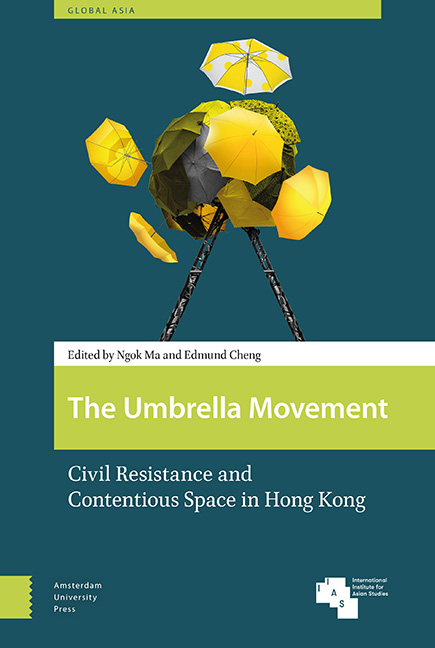Book contents
- Frontmatter
- Contents
- Acknowledgements
- Introduction: Civil Resistance and Contentious Space in Hong Kong
- Part A Trajectory and Contingency
- Part B Repertories and Strategies
- Part C Regime and Public Responses
- Part D Comparative Perspectives
- Appendix: The Umbrella Movement—Chronology of Major Events
- Index
- Publications/Global Asia
13 - Hong Kong Now, Shanghai Then
Published online by Cambridge University Press: 21 November 2020
- Frontmatter
- Contents
- Acknowledgements
- Introduction: Civil Resistance and Contentious Space in Hong Kong
- Part A Trajectory and Contingency
- Part B Repertories and Strategies
- Part C Regime and Public Responses
- Part D Comparative Perspectives
- Appendix: The Umbrella Movement—Chronology of Major Events
- Index
- Publications/Global Asia
Summary
Abstract
This chapter explores the striking similarities, despite important differences in context and setting, between the protests in Hong Kong in recent years and those in Shanghai at various points in the past, including the year 1919. It draws on the author's research on pre-1949 Shanghai student-led mass movements, the subject of his dissertation and first book, and his observations of the demonstrations in Shanghai in 1986 and during visits to Hong Kong between 2014 and 2017.
Keywords: Shanghai, Tiananmen, solidarity, Poland, democracy, Goddess of Democracy, Adam Michnik
In late September of 2017, a traveler from California taking photos of campus bulletin boards in Hong Kongs felt an odd sense of familiarity. Two characters kept being included in his shots: min (“people”) and zhu (“rule”), which together mean “democracy.” He was taking the photographs in part because he thought that the protest posters student activists had posted would soon either be taken down or, as had already begun to happen, be covered by sheets of paper with different sorts of messages. The traveler felt like he had done the same exercise before—in Shanghai, in 1986. He had a vague memory of including a photograph in his first book that would confirm whether his memory was accurate or playing a trick on him. So, when he returned to the United States he found a copy of that book, Student Protests in Twentieth-Century China: The View from Shanghai, and flipped through it. Sure enough, the shot he was thinking of was there, in a photo spread that begins after page 318.
Taken in late 1986, when the now 56-year-old history professor was a graduate student just shy of his 26th birthday, the photo shows students gathering in front of a bulletin board on a Shanghai campus during the now largely forgotten wave of protests that served as a sort of dress rehearsal or prequel for the Tiananmen struggle. The easiest characters to make out in the shot are min and zhu. The historian remembers that he took this photo to help document the look and feel of the movement, feeling a sense of urgency since he was pretty sure the posters would not be visible for long. And he was right: within days, the campus bulletin boards displayed only official materials.
- Type
- Chapter
- Information
- Umbrella MovementCivil Resistance and Contentious Space in Hong Kong, pp. 335 - 346Publisher: Amsterdam University PressPrint publication year: 2019

